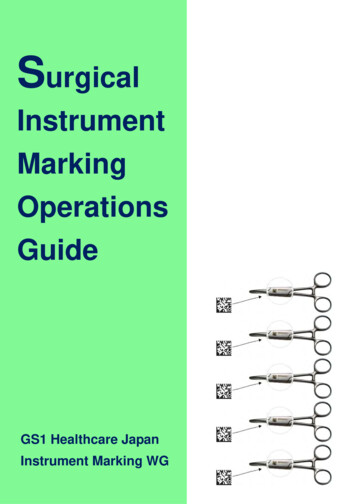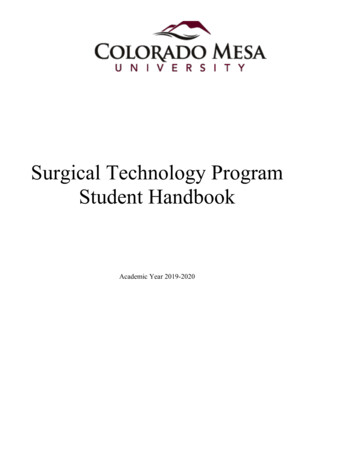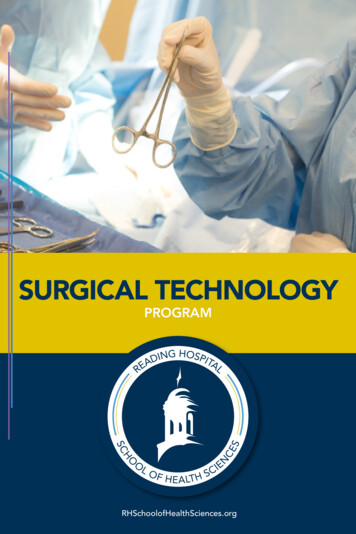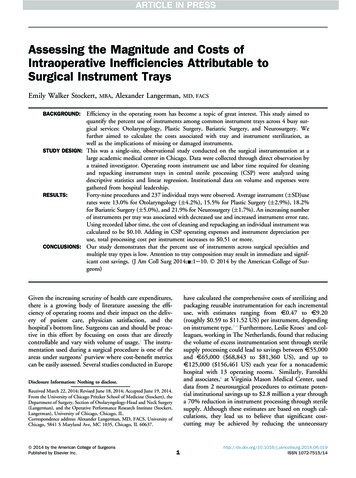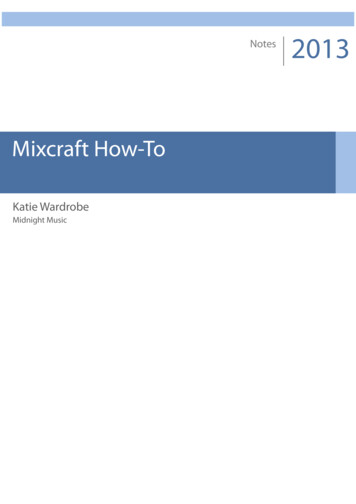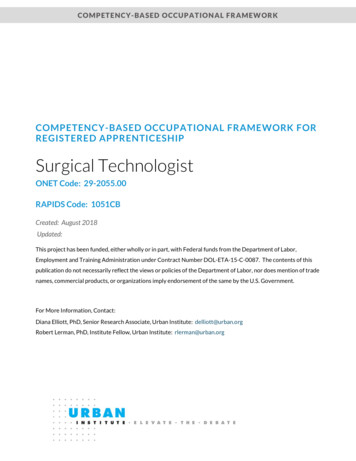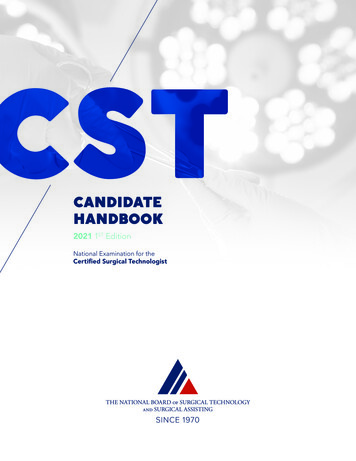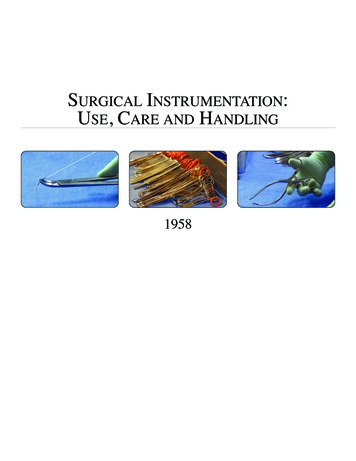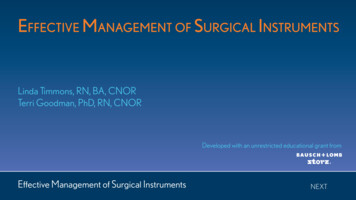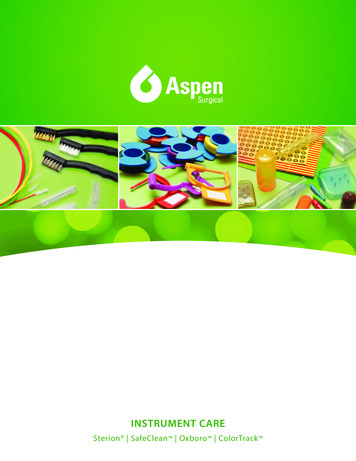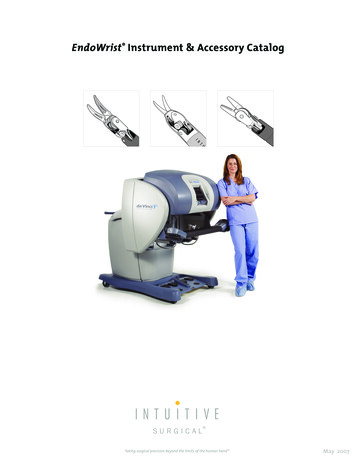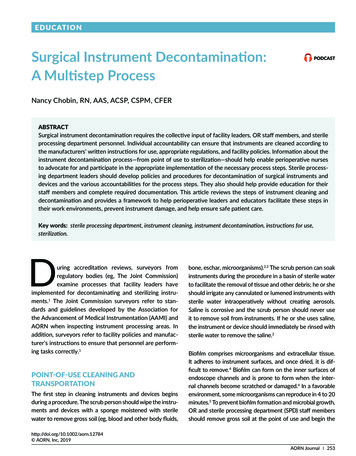
Transcription
EDU C AT I O NSurgical Instrument Decontamination:A Multistep ProcessNancy Chobin, RN, AAS, ACSP, CSPM, CFERABSTRACTSurgical instrument decontamination requires the collective input of facility leaders, OR staff members, and sterileprocessing department personnel. Individual accountability can ensure that instruments are cleaned according tothe manufacturers’ written instructions for use, appropriate regulations, and facility policies. Information about theinstrument decontamination process—from point of use to sterilization—should help enable perioperative nursesto advocate for and participate in the appropriate implementation of the necessary process steps. Sterile processing department leaders should develop policies and procedures for decontamination of surgical instruments anddevices and the various accountabilities for the process steps. They also should help provide education for theirstaff members and complete required documentation. This article reviews the steps of instrument cleaning anddecontamination and provides a framework to help perioperative leaders and educators facilitate these steps intheir work environments, prevent instrument damage, and help ensure safe patient care.Key words: sterile processing department, instrument cleaning, instrument decontamination, instructions for use,sterilization.During accreditation reviews, surveyors fromregulatory bodies (eg, The Joint Commission)examine processes that facility leaders haveimplemented for decontaminating and sterilizing instruments.1 The Joint Commission surveyors refer to standards and guidelines developed by the Association forthe Advancement of Medical Instrumentation (AAMI) andAORN when inspecting instrument processing areas. Inaddition, surveyors refer to facility policies and manufacturer’s instructions to ensure that personnel are performing tasks correctly.1POINT- OF- USE CLEANING ANDTRANSPORTATIONThe first step in cleaning instruments and devices beginsduring a procedure. The scrub person should wipe the instruments and devices with a sponge moistened with sterilewater to remove gross soil (eg, blood and other body fluids,bone, eschar, microorganisms).2,3 The scrub person can soakinstruments during the procedure in a basin of sterile waterto facilitate the removal of tissue and other debris; he or sheshould irrigate any cannulated or lumened instruments withsterile water intraoperatively without creating aerosols.Saline is corrosive and the scrub person should never useit to remove soil from instruments. If he or she uses saline,the instrument or device should immediately be rinsed withsterile water to remove the saline.2Biofilm comprises microorganisms and extracellular tissue.It adheres to instrument surfaces, and once dried, it is difficult to remove.4 Biofilm can form on the inner surfaces ofendoscope channels and is prone to form when the internal channels become scratched or damaged.4 In a favorableenvironment, some microorganisms can reproduce in 4 to 20minutes.5 To prevent biofilm formation and microbial growth,OR and sterile processing department (SPD) staff membersshould remove gross soil at the point of use and begin thehttp://doi.org/10.1002/aorn.12784 AORN, Inc, 2019AORN Journal253
Chobin September 2019, Vol. 110, No. 3cleaning process as soon as possible after use (Figure 1).2,3Some instrument and device manufacturers now indicatethat their products should be cleaned immediately after useor within a specified time frame (eg, 30 minutes from thetime of use). Prompt cleaning also decreases the instrumentcorrosion that may occur after contact with blood, saline, andother chemicals (eg, hemostatic agents) during the surgicalprocedure. When staff members do not remove gross soilfrom instruments at the point of use, it increases the SPDtechnician’s workload and lengthens instrument cleaningtimes, which may negatively affect patient care.Flexible EndoscopesFlexible endoscopes (eg, cystoscopes, ureteroscopes, gastrointestinal [GI] endoscopes, bronchoscopes) used duringprocedures require point- of- use cleaning (ie, at the bedside) before they are sent to the SPD.6 The scrub personshould remove organic soil and biofilm completely to helpensure the subsequent high- level disinfection or sterilization process is effective. Commercial products may reducebioburden and keep soils moist on flexible endoscopes;however, the scrub person or SPD technicians should notuse these products unless the manufacturer has validatedthat the chemicals in the product are acceptable for usewith endoscopes. Scrub persons should perform point- of- care cleaning to prevent secretions and tissues fromdrying, adhering to the endoscopes, and creating biofilm,which makes cleaning difficult.6,7Staff members who process flexible endoscopes need tofollow the written instructions for use (IFU) from both theAendoscope and cleaning solution manufacturers. Someendoscope manufacturers (especially those of flexible GIendoscopes) recommend that cleaning be performed nomore than one hour after precleaning. Therefore, scrubpersons should note the time that the precleaning was performed and relay this information with the endoscope toalert the GI or other endoscope technician of the time elapsedsince the precleaning. If staff members do not begin manualcleaning within the specified time frame, they should followthe endoscope manufacturer’s IFU for delayed reprocessingprocedures. If staff members are not able to begin the cleaning process immediately because the endoscope is neededfor repeat uses during a procedure, designated personnel (eg,RN circulator, anesthesia technician) should follow the manufacturer’s IFU and complete point- of- use cleaning of externalsurfaces and clean internal channels with water.6End- of- Procedure Preparation for TransportSurgical team members should consider any instrumentor device that has been opened for a surgical procedureto be contaminated after it is removed from sterile packaging, even if the item was not used.2,3 Therefore, at theend of the procedure, the scrub person should open anddisassemble (if multipart) all instruments and devices asdirected by the manufacturers’ written IFU. Additionally,AORN and AAMI do not recommend the restringing ofinstruments when sent to SPD.2,3 If stringers were used,they would need to be wide enough apart for the instruments to be sufficiently open so as to be adequately exposed to the detergent and water in the ultrasoniccleaner and mechanical washer. Additionally, when usingBFigure 1. Orthopedic stems that were not pretreated and were left in the dirty utility room of the OR during aweekend (A). Sterile processing department technicians required 18 hours to clean them effectively. Photographcourtesy of Nancy Chobin. Instrument set that has had gross soil removed in the OR after use (B). Photographcourtesy of Case Medical, Inc, South Hackensack, NJ.254AORN Journal
September 2019, Vol. 110, No. 3 Surgical Instrument Decontaminationa stringer, SPD personnel would need to devise a methodfor keeping the instruments in an upright, vertical positionfor effective cleaning. This is not always feasible becauseof the design of most ultrasonic and mechanical washers.After cleaning, the SPD technician would need to removethe stringer from the instruments to inspect them.At the end of the procedure, the scrub person mustremove all disposable sharp objects from instrumentsand devices and place them in a sharps container to prevent SPD technicians from experiencing an occupational bloodborne pathogen exposure.2,3,8 The scrub personshould place delicate items in a separate specialty container to prevent damage during transport (Figure 2).Many specialty containers provide secure holders tomaintain the instruments’ positions during transport.The scrub person should place each instrument in itsdesignated location in the container to prevent damage(Figure 3). The scrub person should have an easy way tonotify SPD technicians when instruments require repair.One method is for the scrub person to apply an autoclavable tag to the instrument so the SPD technicians knowto remove the instrument from service after they complete the cleaning process.2,3 In addition, staff membersshould take precautions to minimize instrument damage.This includesFigure 2. A camera placed securely in a protectiverigid container before transport. Photograph courtesy of Case Medical, Inc, South Hackensack, NJ. protecting tips and other parts of fragile instruments; separating and containing any reusable instrumentsthat may cause injuries to SPD personnel; organizing the instrument container with the larger andheavier instruments on the bottom to protect the lighter and fragile instruments on top; avoid placing instruments in basins with solutionbecause the solution can spill in transit or upon removal, contaminating personnel or the environment; and avoid separating used instruments from unusedinstruments.2,3Although staff members may want to expedite the roomcleaning processes in anticipation of a subsequent procedure, when they place instruments in the wrong trays ordo not protect them from damage, they can cause delaysin instrument processing and preparation (Figure 4). Inaddition, the facility may incur significant costs to repairor replace instruments, and the number of available instruments in the tray may be reduced when instruments are notavailable because of damage.Figure 3. A retractor set with the blades andattachments arranged in the designated areas ofthe instrument pan. Photograph courtesy of CaseMedical, Inc, South Hackensack, NJ.Before sending the instruments to SPD, the scrub person isresponsible for keeping the instruments moist to facilitateremoval of organic soil, a major factor in cleaning.2,3 Scrubpersons have three options to maintain the moisture of soils,which are listed as follows. Use an enzymatic product designed for pretreatmentof instruments that does not aerosolize (ie, not liquids).This type of product varies in odor, may be a foam orgel, and varies in the length of time it maintains moistureAORN Journal255
Chobin ASeptember 2019, Vol. 110, No. 3BFigure 4. An example of the incorrect way to gather instruments at the end of a procedure (A). Robotic, laparoscopic, and other instruments are mixed together without organization; sharp tips and expensive instrumentsare not protected. Photograph courtesy of Nancy Chobin. An example of a set of separated instruments thathave been pretreated and placed in their respective locations in the basket (B). Photograph courtesy of CaseMedical, Inc, South Hackensack, NJ.(ie, 24 hours to several days). Scrub persons should follow the manufacturer’s IFU and apply the product to allsurfaces of the instruments. Cover the instruments with a moist towel, place theinstruments in a biohazard bag or puncture-proof biohazard container, and close the containment device toprevent the moisture from evaporating. Use water, notsaline, to moisten the towel. Place instruments into a commercial self-sealed pouchthat will keep soils moist (Figure 5).Surgical Instruments and Known or SuspectedCreutzfeldt- Jakob Disease (CJD) PatientsCreutzfeldt- Jakob disease is caused by prions, which areinfectious proteinaceous materials that are very difficultto remove from instruments.9 Because prion transfer hasbeen shown to take place during neurological surgeries,only those instruments used on patients at an increasedrisk for CJD who are in direct contact with high- risk tissue (eg, spinal cord; posterior eye or brain procedures,including pituitary) are of concern. Any reusable instruments that contact high- risk tissue should be designed tobe easily cleaned, and SPD leaders should have validationfrom the manufacturer that the instruments can tolerateexposure to extended sterilization cycles.2,3 Single- useinstruments are available for CJD procedures (eg, single- use brain biopsy sets), and SPD leaders should collaboratewith surgeons and perioperative leaders to ensure theinstruments meet the needs of the surgical team. The SPDtechnicians can use cleaning processes that have been256AORN Journal Figure 5. Pretreated surgical instruments in a self- sealed pouch to maintain moisture. Photographcourtesy of Healthmark Industries Company, Inc,Fraser, MI.shown to reduce prion infectivity safely to process devicescontaminated with low- risk tissue (eg, cerebrospinal fluid;tissue from lymph nodes or organs, including kidney, liver,spleen, or lung) or no- risk tissue (eg, urine, feces, blood,bone marrow). These methods include steam sterilizationand hydrogen peroxide gas sterilization.2,3After use, the scrub person should identify all instruments or devices that require special prion processingand place those items in rigid containers.9 The scrub person should keep instrument soils moist using one of the threemethods previously described, immediately send the instruments to SPD for reprocessing to help facilitate prion removal from the instruments, and
September 2019, Vol. 110, No. 3 identify the instruments with a special label (eg,SPECIAL PRION PROCESSING) attached to the container or bin.2As a precaution, surgical and SPD team members shouldtreat all loaner spinal and neurological instruments receivedfrom a vendor representative as though contaminated withprions.9 Because the history of the loaned instruments isunknown, the SPD technicians should clean the instruments according to the manufacturer’s IFU and sterilizethem by using extended cycles as recommended by theAAMI.3Surgical Instrument Decontaminationand containment of bioburden.3 Ideally, the area shouldbe physically separated from other areas of the processingdepartment; access to this area should be from an outside corridor.3 Many SPD departments are responsible forprocessing instruments and devices for the OR and manyother departments (eg, labor and delivery, interventionalradiology, cardiac catheterization laboratory), and sometimes for physician offices and offsite ambulatory healthcare centers. This can result in thousands of instrumentspassing through the SPD on a daily or weekly basis. Afterthe instruments arrive in the decontamination area, SPDtechnicians sort, wash, rinse, and dry them before they aretransferred to the sterilization area of the SPD.Transporting Contaminated InstrumentsSurgical personnel must contain contaminated items inclosed bins or carts to prevent accidental contaminationwhen transporting them from the procedure area to thedecontamination area in the SPD.2,3,8 If SPD technicians areresponsible for collecting the used instruments in multipleprocedure areas, the SPD leaders should design the collection schedule to limit the transport time efficiently and avoidhigh- traffic areas.3 Sometimes staff members may use a dirtyand clean dumbwaiter system to send and receive instruments. The Occupational Safety and Health Administrationrequirement for transport mandates that any container witha contaminated item must be identified (eg, red bag, biohazard label), puncture resistant, closeable, and leakproof(ie, sides and bottom).8 All transport containers should becleaned and disinfected after each use. Therefore, facility leaders should provide only carts or bins that have IFUfor decontamination (eg, cleaning in a washer, using a cartwasher, disinfecting with an approved disinfectant).2,3DECONTAMINATION AREA OF THE SPDFacility leaders should design the decontamination areaof the SPD to provide for efficient and effective cleaningand to minimize and contain potential environmental contamination.2,3 Items in the decontamination area may becontaminated with blood or other body fluids, tissue, andunidentified microorganisms that could be pathogenic. TheSPD technicians should handle all items as if they representa significant health risk because the type and level of contamination on items to be processed is typically unknown.Whenever possible, the process of decontaminatingmedical devices should be centralized in one location toaccomplish consistent, effective, and efficient processingSafety in the Decontamination AreaThe SPD technicians may be exposed to a variety of hazardous materials, including microorganisms, chemicals,and sharps. In addition to usual surgical attire, personnelassigned to the decontamination area wear personal protective equipment (PPE) consisting of a fluid-resistant face mask and eye protection (eg, goggles, full-length face shields) that protects the wearerfrom splashes, a fluid-resistant gown or jumpsuit with sleeves (may bebackless), utility-type gloves that cover the cuff of the gown andare fitted at the wrist to prevent contact of contaminated solutions with the technician’s skin, and fluid-resistant shoe covers.2,3After instruments and devices arrive in the decontamination areas, technicians are responsible for sorting them toidentify contaminated sharps and delicate items that needto be segregated to prevent damage.10 When working toidentify any remaining sharps, staff members in any areashould never blindly reach into a basket of instruments.Some SPD leaders may require SPD technicians to use asponge stick to sort through the instruments in search ofa sharp item that could cause a puncture injury and exposure. The technicians should separate any basins and anymicrosurgical instruments from the general instruments.10They should remove nonimmersible items (eg, powerequipment) and items to be cleaned manually (eg, rigidendoscopes) from the tray. Finally, they should removeany silicone mats or other protective devices for separatecleaning.AORN Journal257
Chobin CLEANING AND DECONTAMINATIONWhen cleaning and decontaminating instruments, theSPD technicians should follow the manufacturer’s IFUfor each instrument.3 Many specialty instruments (eg,orthopedic, spinal, robotic) have complex cleaning protocols that need to be followed, and current IFU shouldbe easily accessible in the decontamination area for theSPD technicians. The cleaning process includes four general steps.31. Verify that all hinged instruments are in the fullyopened position.2. Disassemble any multipart instruments for cleaning (ifrecommended by the device manufacturers).3. Thoroughly rinse the instruments to remove any enzymatic foam or gel product that might have been used topretreat the instruments. If another method was usedto keep the soils moist (ie, self-sealed pouch), then theinstruments should be thoroughly rinsed to removegross soil.4. Manually soak the instruments in a neutral-pH enzymatic detergent for the amount of time specified bythe detergent manufacturer unless otherwise specifiedby the device manufacturer.The SPD technicians may use enzymatic solutions (eg, proteases) to help remove organic debris from instruments.11These enzymes work on the proteins that are common inblood and tissue. The technicians also may use cleaningsolutions that contain lipases and amylases to break downfats and starches. Some solutions contain one enzyme;others contain more than one. These enzymatic cleanersare not disinfectants and may be inactivated by germicides.After the technicians use the enzymatic solutions on theinstruments, it is important that they rinse the instrumentsto remove the solution and associated debris to preventproteinaceous residue and adverse reactions (eg, fever).11Enzymatic detergents can be temperature sensitive, andSPD technicians should follow the detergent manufacturer’s IFU for water temperature and monitor the water temperature during the cleaning process.Because most detergents are not microbicidal, SPD technicians should change the manual detergent solution aftereach use as specified by applicable polices.3,11 The AAMIalso states that facilities should determine what constitutes a “use.”3 They should dilute the detergents accordingto the IFU and thoroughly rinse the detergent from theinstruments using tap water after the enzymatic presoak.258AORN Journal September 2019, Vol. 110, No. 3The SPD technicians require nonlinting cloths to cleaninstruments and different sizes of cleaning brushes toclean the lumens of instruments according to the manufacturer’s IFU. Although the technicians may use reusable cloths, they should be clean, nonlinting, and changedfrequently.3 Brushes can be reusable or single use; thetechnicians should clean reusable brushes after each useand should either disinfect or sterilize them daily.3,11 It isimportant to purchase brushes that have IFUs for cleaning,disinfection, or sterilization. The SPD technicians shouldcontinually inspect reusable brushes for damage or wearand verify that they are in good condition and can effectively clean the instruments. The technicians should discard single- use brushes after use.Manual CleaningThe SPD technicians should perform manual cleaning of allinstruments if mechanical cleaning equipment is not available or not operational and when the manufacturer’s IFUrequires it (eg, microsurgical instruments, rigid endoscopes,power equipment).2,3 Unless otherwise directed by thedevice manufacturer’s IFU, they should use low- foaming,neutral- pH enzymatic detergents or neutral- pH manual- cleaning detergents that prevent instrument damage andallow the technician to see what they are cleaning. TheSPD technicians should submerge the soiled instrumentin the detergent solution to decrease aerosolization ofcontaminants and thoroughly rinse the item after manualcleaning. The sink area should have three wells to facilitatethis process: one for soaking and washing, one for rinsing,and one for the final rinse.3 If required by the manufacturer’s IFU, the technicians should perform the final rinse withtreated water (eg, reverse osmosis water).2,12Mechanical CleaningAlthough there are many types of mechanical cleaningequipment available for SPD use, ultrasonic cleanersand mechanical washers are the most common. The SPDtechnicians should refer to the manufacturer’s IFU forspecific information related to equipment in their facility.Ultrasonic cleaningUltrasonic cleaning is an effective way to remove soils fromall surfaces, including hard- to- reach areas such as ratchetsand box locks. The SPD technicians can use this methodafter soaking and rinsing instruments to remove gross soils.2,3
September 2019, Vol. 110, No. 3 Ultrasonic cleaning uses a generator to supply high- frequency sound waves to a tank filled with a dilutedaqueous cleaning solution. Different types of ultrasoniccleaners are intended for use with different instruments.2,3The ultrasonic waves create areas of varying pressure;during low pressure, they create microscopic bubblesthat are imploded during high pressure. This process iscalled cavitation, and it disrupts the bonds holding theparticulate matter to the instrument in every area thatthe solution touches.2,3 Generally, there is no bactericidalcomponent to this process. Although many manufacturersrecommend ultrasonic cleaning, SPD technicians shouldonly use it when specified in the IFU for a specific device.After filling the ultrasonic unit with detergent and water(in larger units, the detergent is automatically dispensed),the SPD technicians should follow the manufacturer’s IFUand run the appropriate cycle to release trapped air in thesolution, a process called degassing.2,3 When air remainsin the solution, the cavitation process is ineffective.Ultrasonic cleaning cycles vary in length and generally range from 5 to 20 minutes; the cycles depend on theinstrument manufacturer’s recommendations. These cleaners are effective only when used properly. The SPD technicians should not place plastic trays inside the unit becauseplastic absorbs the sound waves and interferes withthe cleaning process.10 They also should not stack trays(Figure 6)10 or mix different types of metal instruments inthe same load because this may cause instrument damage.2Generally, detergents used in the ultrasonic cleaner are notSurgical Instrument Decontaminationmicrobicidal; therefore, SPD technicians should change thesolution in the ultrasonic cleaner frequently and the SPDleader should determine the schedule for changing it.After the ultrasonic cycle is complete, SPD techniciansshould thoroughly rinse the instruments with tap waterbefore the next step (usually mechanical washing) begins.If the final cleaning step is the ultrasonic cleaning, thetechnicians should use critical water that has been treatedto remove microorganisms and organic or inorganic materials for the final rinse.3 The SPD technicians should testthe ultrasonic cleaner daily to verify that the unit is functioning properly and document the results of the testing.2,3Mechanical washerCleaning and decontamination are different processes;cleaning does not remove pathogenic microorganisms frominstruments or make them safe to handle, use, or discard.3Therefore, SPD technicians usually need to use an additional method to achieve decontamination. Often, a mechanicalwasher is appropriate for the next instrument processingstep (if not contraindicated by the instrument manufacturer). Many facilities have a washer- decontaminator thatcleans and decontaminates instruments so they are safe tohandle without the need for personnel to wear PPE in thepreparation and packaging area.Washers may have operational malfunctions, so SPDtechnicians should perform a daily check of the washerbefore use and document the findings.2,3 The techniciansFigure 6. Incorrectly stacked instrument trays in the ultrasonic cleaner (A). Photograph courtesy of NancyChobin. Ultrasonic cleaner loaded correctly with lumened devices (B). Photograph courtesy of Ultra CleanSystems, Inc, Oldsmar, FL.AORN Journal259
Chobin September 2019, Vol. 110, No. 3Key Takeaways Surgical instrument decontamination requires that team members pay close attention to their specific rolesin the appropriate preparation, labeling, transport, and cleaning of the various instruments and equipmentused during operative and other invasive procedures.The scrub person begins cleaning instruments and devices during the procedure and should wipe the instruments and devices with a sponge moistened with sterile water to remove gross soil (eg, blood and otherbody fluids, bone, eschar, microorganisms).Surgical personnel must contain contaminated items in closed bins or carts during transport from the pointof use to the decontamination area in the sterile processing department.When cleaning and decontaminating instruments, the sterile processing department technicians shouldfollow the manufacturer’s instructions for use for each instrument.Sterile processing department leaders are responsible for developing appropriate policies for their areas,including policies that address accountability for surgical instruments and the steps and processes involvedin the decontamination of surgical instruments.may need to verify the spray arms move freely and are notclogged and clean the drain strainers (ie, remove any smallitems that might have accumulated inside). The manufacturer’s IFU should specify all required checks.Most mechanical washers have several cleaning anddecontamination cycles that vary with the make andmodel of the washer. Cycles may include a cold- waterrinse, wash, rinse, instrument lubrication cycle, and drying. Mechanical washers use several chemicals that mayinclude an enzymatic detergent, a mechanical cleaner,and an instruments lubricant (if applicable).2,3 The SPDleader should follow instrument manufacturer recommendations when selecting the detergents to be usedin their washers. Many surgical instrument manufacturers recommend a neutral- pH detergent for cleaning, andsome orthopedic instrument manufacturers specify thattheir instruments should not be subjected to alkalinedetergents.Many washers have a variety of preprogrammed cyclesthat are specific for utensils (eg, basins, bowls), instruments, delicate instruments, or instruments with heavysoil (eg, orthopedic instruments).10 Some implant manufacturers specify that their implants (eg, screws) shouldnot be subjected to instrument lubricant, and many washers can be programmed for this requirement.The SPD technicians need to know how to load the washer correctly because the detergent and water should beable to contact all surfaces of the instruments. The SPD260AORN Journal technicians should not place bowls, cups, and other similaritems on top of instruments because they could preventthe detergent from reaching some of the surface areas.10They should separate the trays of multilevel sets and placethe individual trays in the washer separately and removeall instruments from their sterilization containers duringcleaning. If SPD technicians do not adhere to the manufacturer’s requirements for loading the washer, a cleaningfailure may occur.POLICIES AND PROCEDURESSterile processing department leaders are responsiblefor developing appropriate policies for their areas. Twoimportant policies for the decontamination area of theSPD address accountability for surgical instruments andthe steps and processes involved in the decontamination of surgical instruments.10 The accountability policy describes the steps to be taken at the end of thesurgical procedure in the OR and transportation of theused instruments to the decontamination area in theSPD. The second policy details the steps and equipmentneeded for the effective decontamination of instruments and devices. Without well- written policies andprocedures, accountability and consistent processes donot exist. The SPD leaders should develop the facility’spolicies and procedures with input from infection preventionists using national practice guidelines (eg, AAMI,AORN, Occupational Safety and Health Administration)and should include references to the relevant standardsor guidelines used in their development.2 Departmental
September 2019, Vol. 110, No. 3 leaders who interface with the SPD (eg, OR, labor anddelivery, interventional radiology, cardiac catheterization laboratory)
Surgical team members should consider any instrument or device that has been opened for a surgical procedure to be contaminated after it is removed from sterile pack-aging, even if the item was not used.2,3 Therefore, at the end of the procedure, the scrub person should open and
